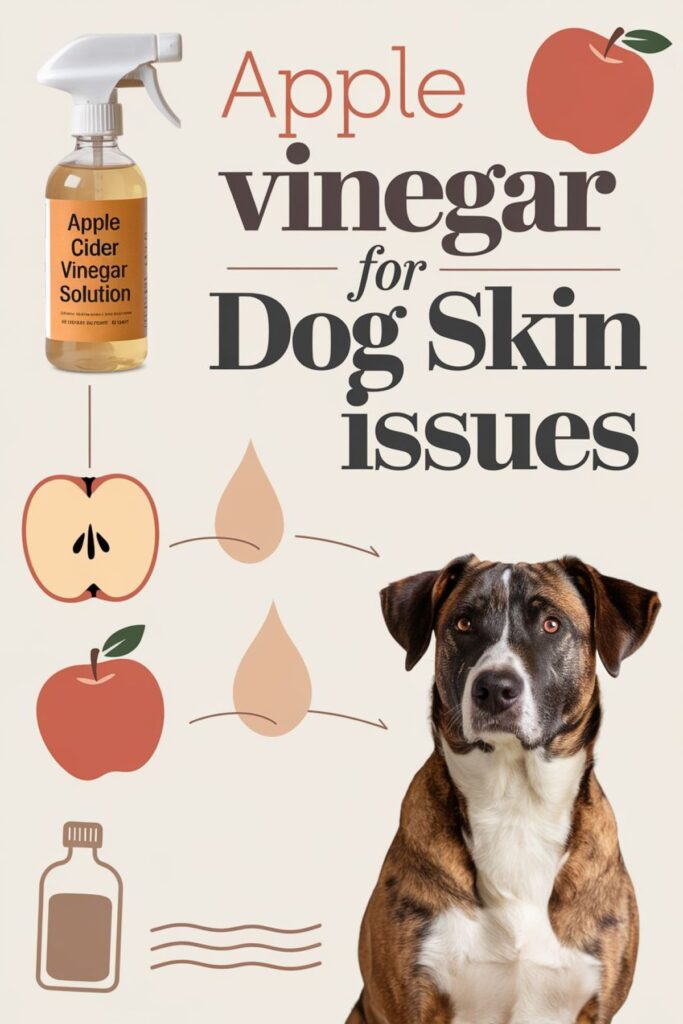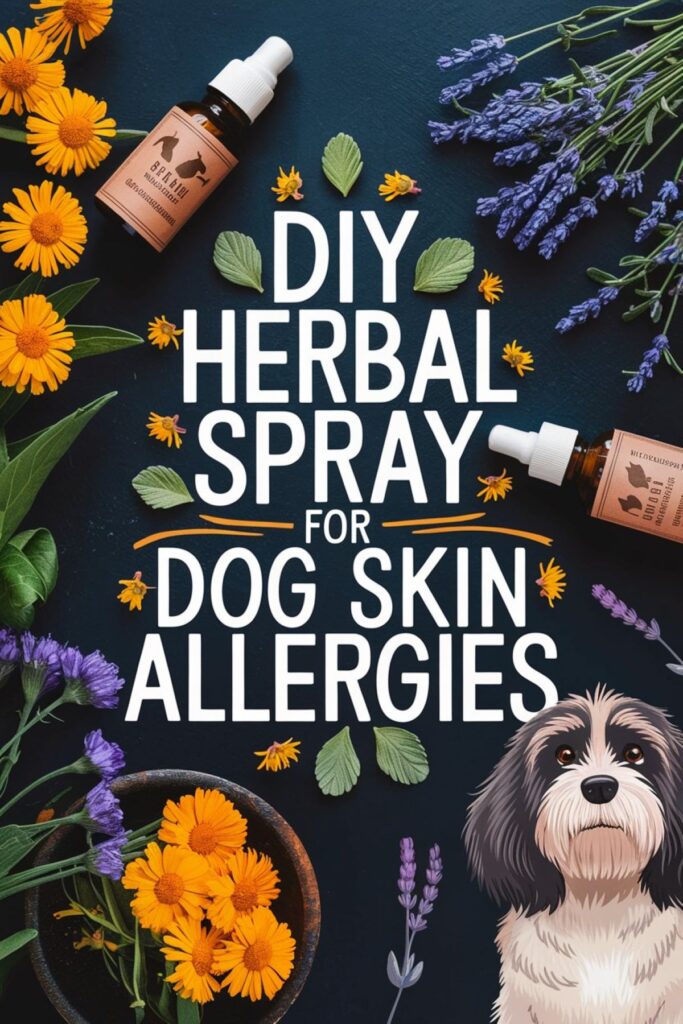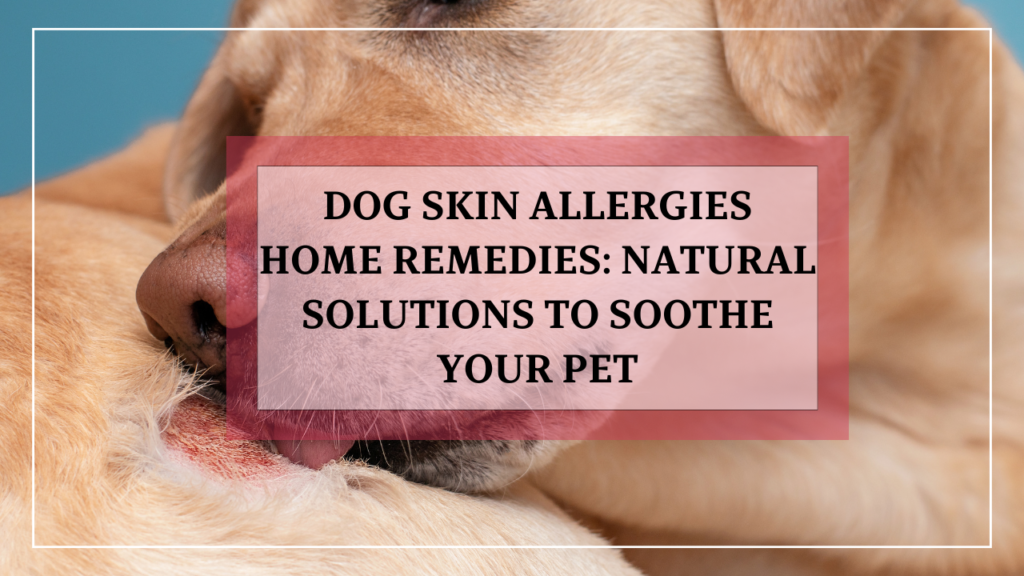Skin allergies in dogs are a common issue that many pet owners face. Whether it’s due to environmental allergens, food sensitivities, or flea bites, seeing your dog constantly scratching, biting, or licking can be heartbreaking. While prescription medications and vet-recommended treatments can help, many pet owners prefer natural, home remedies to provide relief. These solutions often come with fewer side effects and can be gentler on your dog’s body, making them a popular choice for managing mild to moderate allergies.
In this guide, we’ll explore various dog skin allergies home remedies to help soothe your pet’s discomfort. From oatmeal baths to coconut oil, these simple remedies can be done right at home, using natural ingredients that are safe for dogs. But before diving into the remedies, let’s first take a look at the underlying causes of dog skin allergies, so you can understand what might be triggering your pet’s symptoms.
What Causes Skin Allergies in Dogs?
Skin allergies in dogs can be triggered by a variety of factors. These triggers are often divided into three main categories: environmental allergens, food allergies, and flea allergies. Understanding the root cause of your dog’s skin allergy is key to finding the right treatment, whether it’s a natural remedy or something prescribed by a vet.
1. Environmental Allergens
Environmental allergens are a leading cause of skin allergies in dogs. Common triggers include pollen, mold, dust mites, and even grass. These allergens can be seasonal, causing your dog’s symptoms to flare up at certain times of the year, or they can be present year-round.
- Fact: Dogs can develop allergies at any age, but symptoms often begin between 1 and 3 years of age.
- Case Study: According to the American Kennel Club, certain dog breeds, such as Golden Retrievers and Bulldogs, are more prone to environmental allergies than others.
2. Food Allergies
Food allergies are another major contributor to dog skin problems. Some dogs are allergic to specific proteins (such as chicken, beef, or dairy), while others may react to grains or artificial additives in their food. The symptoms of food allergies can often mimic other types of allergies, making them difficult to diagnose without an elimination diet.
- Common Food Allergens:
- Chicken
- Beef
- Dairy products
- Wheat
- Soy
3. Flea Allergies
Flea allergy dermatitis (FAD) is one of the most common causes of itching and irritation in dogs. When a flea bites, it injects saliva into the dog’s skin, which can trigger an allergic reaction in sensitive dogs. Even a single flea bite can cause intense itching that lasts for days.
- Fact: It’s estimated that 50% of dogs with flea infestations will develop flea allergy dermatitis.
Symptoms of Dog Skin Allergies
It’s crucial to recognize the symptoms of dog skin allergies so you can take action early. While itching is the most common sign, other symptoms may include:
- Red, inflamed skin
- Hot spots (localized areas of irritated skin)
- Excessive licking or biting
- Hair loss in affected areas
- Chronic ear infections (especially with food allergies)
Dogs may experience one or a combination of these symptoms depending on the severity of the allergy. If your dog is showing signs of a severe reaction, such as swelling, hives, or difficulty breathing, seek veterinary help immediately.
Understanding the Difference Between Skin Allergies and Other Skin Conditions
It’s important to differentiate between skin allergies and other skin conditions like fungal infections, mange, or dry skin. While allergies often cause widespread itching and irritation, these other conditions may present differently. For example:
- Mange can cause hair loss and scabs.
- Fungal infections like ringworm often result in circular patches of hair loss and flaky skin.
If you’re unsure whether your dog’s symptoms are due to an allergy or something else, consult your vet for a proper diagnosis.
Natural Home Remedies for Dog Skin Allergies
Finding the right home remedies can make a noticeable difference in your dog’s comfort and well-being. These natural solutions focus on ingredients that are generally safe, easy to apply, and known for their soothing effects on irritated skin. Let’s take a closer look at each option and how it can help.
Oatmeal Baths for Soothing Itchy Skin
Why Oatmeal Works for Skin Allergies
Oatmeal has long been a popular remedy for skin irritation in both humans and dogs. This natural ingredient contains compounds called avenanthramides and phenols, which provide anti-inflammatory and antioxidant benefits. These compounds help calm the skin, relieve itching, and reduce redness by blocking the release of chemicals that trigger inflammation. Additionally, oatmeal creates a protective barrier on the skin, locking in moisture and helping to restore the skin’s natural balance.
How to Prepare and Use an Oatmeal Bath at Home
Giving your dog an oatmeal bath is straightforward. Here’s how to prepare and use it:
- Grind Plain Oats: Use about one cup of plain, unflavored oatmeal (avoid oats with additives). Grind it into a fine powder using a food processor or blender until it resembles flour.
- Prepare a Warm Bath: Fill a tub with lukewarm water. Avoid hot water, as it can worsen the irritation.
- Add Oatmeal: Stir the powdered oatmeal into the water until it’s evenly distributed and the water looks milky.
- Soak Your Dog: Place your dog in the tub and gently pour the oatmeal water over their skin. Let them soak for 10-15 minutes, making sure to cover all affected areas.
- Rinse and Dry: After soaking, rinse your dog with lukewarm water to remove any oatmeal residue. Pat them dry with a soft towel, being careful not to rub the irritated areas.
Frequency of Use and Precautions
- Frequency: For dogs with frequent itching, an oatmeal bath once a week can be beneficial. If symptoms improve, reduce to every two weeks.
- Precautions: Make sure the oatmeal is finely ground, as larger pieces may not dissolve well and could irritate the skin further. Also, avoid using oatmeal baths if your dog has any open wounds or raw areas, as this could lead to infection.
Aloe Vera Gel for Cooling and Healing
Benefits of Aloe Vera for Skin Irritation
Aloe vera is widely used for its cooling, soothing, and healing properties. It contains polysaccharides that promote cell regeneration and provide a protective layer on the skin, making it an excellent remedy for reducing inflammation and healing minor irritations. Aloe also contains glycoproteins, which reduce pain and inflammation, and antioxidants that help repair damaged skin.
How to Apply Aloe Vera Safely
- Choose Pet-Safe Aloe Vera Gel: Make sure to use 100% pure, pet-safe aloe vera gel with no additives or preservatives. Some products intended for humans may contain alcohol or other chemicals that can be harmful to dogs.
- Spot Test: Before applying aloe vera gel to large areas, test it on a small patch of skin to check for any adverse reactions.
- Apply Gently: Apply a thin layer of aloe vera gel to the affected area, rubbing it in gently. Allow the gel to sit on the skin and avoid rinsing.
Areas to Avoid and Potential Side Effects
- Avoid Sensitive Areas: Don’t apply aloe near the eyes, mouth, or open wounds. Aloe vera is mildly toxic when ingested, so make sure your dog doesn’t lick it off.
- Side Effects: While rare, some dogs may experience mild irritation. If redness or swelling occurs, discontinue use and consult your vet.
Coconut Oil for Moisturizing and Anti-Inflammatory Effects

Benefits of Coconut Oil for Skin and Coat
Coconut oil is packed with medium-chain fatty acids that offer powerful moisturizing and anti-inflammatory benefits. It helps create a barrier on the skin, locking in moisture, and is particularly effective for dry, flaky patches caused by allergies. Coconut oil also contains lauric acid, which has antimicrobial properties that may help prevent infection.
Proper Application Techniques
- Choose Organic, Virgin Coconut Oil: Look for unrefined coconut oil, which retains the most beneficial compounds.
- Apply Sparingly: Start with a small amount (about a teaspoon), warming it in your hands. Gently massage it into the affected areas.
- Allow Time to Absorb: Let the coconut oil sit for 5-10 minutes before allowing your dog to roam freely. Excess oil can be wiped off with a soft towel if necessary.
Tips on Frequency and Potential Side Effects
- Frequency: For mild symptoms, apply coconut oil 2-3 times per week. If you notice greasy skin, reduce usage to avoid clogging pores.
- Precautions: Avoid applying too much oil, as it can make your dog’s coat greasy and may cause upset stomach if ingested in large quantities.
Apple Cider Vinegar (Diluted) for Antibacterial Benefits

Benefits of Apple Cider Vinegar for Dog Skin Issues
Apple cider vinegar (ACV) has natural antibacterial and antifungal properties, which make it effective against bacteria and yeast that may aggravate skin allergies. It also helps to restore the skin’s natural pH balance, reducing itchiness and inflammation.
Correct Dilution Ratios to Prevent Irritation
To prevent irritation, always dilute apple cider vinegar:
- Ratio: Mix one part apple cider vinegar with one part water in a spray bottle.
- Spot Test: Test the solution on a small area of skin first to ensure it doesn’t cause a reaction.
How to Apply and When to Avoid
- Apply Gently: Spray the diluted ACV solution onto affected areas. You can also dip a soft cloth in the solution and dab it on the skin.
- Avoid Sensitive Areas: Do not use ACV on broken skin, open wounds, or near the eyes, as it can cause stinging.
- Frequency: For moderate itch relief, use this remedy 1-2 times per week.
Chamomile or Green Tea Rinses for Reducing Inflammation
Benefits of Tea as a Natural Anti-Inflammatory
Chamomile and green tea are known for their anti-inflammatory and antioxidant properties. Chamomile has calming effects, while green tea is packed with antioxidants that can help soothe irritated skin and reduce redness. These teas are mild enough for topical use and can be used to gently relieve itchiness.
How to Brew and Apply a Tea Rinse Safely
- Brew Tea Bags: Place two chamomile or green tea bags in a cup of hot water and let it steep for 10 minutes.
- Cool the Tea: Allow the tea to cool completely before using it on your dog.
- Apply Gently: Pour the tea over the affected areas, or dip a clean cloth into the tea and gently dab it onto the skin.
Tips for Frequency and Cautions
- Frequency: Tea rinses can be applied 2-3 times a week or as needed.
- Precautions: Make sure the tea is fully cooled to avoid burns, and don’t let your dog lick the tea off immediately after application.
DIY Herbal Sprays (Calendula, Neem, Lavender)

Benefits of Specific Herbs for Dog Skin
Certain herbs, like calendula, neem, and lavender, offer additional benefits for skin health:
- Calendula: Known for its healing and anti-inflammatory properties, it can promote skin repair.
- Neem: Has natural antifungal and antibacterial qualities, often used for managing itching.
- Lavender: Provides a calming scent and mild antiseptic properties.
How to Make a Basic Herbal Spray and Apply It Safely
- Create an Infusion: Steep the chosen herb (1-2 tablespoons of dried herbs) in one cup of boiling water for 10-15 minutes.
- Cool and Strain: Let the mixture cool, then strain it into a spray bottle.
- Apply Lightly: Mist the affected areas or gently dab the solution onto the skin with a cloth.
Cautions and Frequency of Use
- Frequency: Use herbal sprays once or twice a week.
- Precautions: Always test a small area first to ensure your dog doesn’t have an allergic reaction. Avoid sensitive areas and areas with broken skin.
How to Diagnose Dog Skin Allergies
Diagnosing dog skin allergies can be challenging, especially since the symptoms can mimic other skin conditions like fungal infections, mange, or even anxiety-related behaviors. Early diagnosis is crucial to providing relief and finding the right home remedy or treatment plan. Below are some of the best approaches to identify whether your dog is dealing with a skin allergy.
When to Consult a Vet for Proper Diagnosis
While it may be tempting to jump straight into using home remedies for dog skin allergies, it’s often a good idea to consult your vet first. A vet can rule out other serious conditions and give you a clear diagnosis. Your vet might perform a variety of tests, such as:
- Skin scrapes: These help to identify mites or other parasites that might be causing the irritation.
- Fungal cultures: If ringworm or another fungal infection is suspected, a culture test can confirm the presence of fungal spores.
- Blood tests: Allergy-specific blood tests can reveal environmental or food allergens that are affecting your dog.
If you’re dealing with chronic or severe allergies, a vet’s guidance can help you focus on remedies that will be the most effective for your dog.
At-Home Methods for Identifying the Cause of Dog Skin Allergies
If a trip to the vet isn’t immediately possible, you can try some at-home methods to identify what’s causing your dog’s allergic reaction.
1. Elimination Diet
Food allergies are tricky to diagnose, but an elimination diet can be highly effective. This method involves feeding your dog a novel protein and carbohydrate source that they haven’t eaten before (such as duck and sweet potatoes) for several weeks.
- If your dog’s symptoms improve during this diet, it’s likely that a food allergy is the culprit.
- You can then gradually reintroduce different food ingredients (one at a time) to see which one triggers the allergic reaction.
Example Diet:
| Novel Protein Source | Carbohydrate Source |
| Duck | Sweet Potatoes |
| Venison | Peas |
| Rabbit | Pumpkin |
- Fact: It can take anywhere from 8 to 12 weeks for the results of an elimination diet to show significant improvement.
2. Seasonal Patterns
Environmental allergies often follow seasonal patterns, especially if they are caused by pollen or grasses. Pay attention to when your dog’s symptoms worsen. Do they only flare up in the spring or summer? If so, it could point to environmental allergens.
3. Observation of Fleas
Flea bites are one of the most common causes of dog skin allergies. If you notice fleas on your dog or in your home, this could be the cause of the allergy. Even if you don’t see them, remember that flea bites are tiny, and some dogs are hypersensitive to just one or two bites. Checking your dog’s fur and using a flea comb can help identify an infestation.
Testing for Allergies: Blood Tests, Skin Scrapes, and Patch Testing
If home remedies and observation aren’t enough to pinpoint the cause of your dog’s skin issues, allergy testing can provide more detailed results.
- Blood Tests: These are commonly used to identify environmental allergens. Your vet will take a sample of your dog’s blood and test it against common allergens like pollen, mold, and dust mites.
- Skin Scrapes: These are performed when your vet suspects parasites like mites. A small sample of skin is scraped off and examined under a microscope.
- Patch Testing: This test can help identify contact allergies. Small amounts of potential allergens are placed on your dog’s skin to see if there is a reaction.
Tip: Some pet owners use home allergy test kits, but it’s important to remember that these aren’t always as accurate as tests performed by a vet. Always consult a professional for serious cases.
How to Prevent Dog Skin Allergies Naturally
Prevention is always better than cure, and taking steps to prevent dog skin allergies can save your dog from a lot of discomfort. While it’s impossible to eliminate all allergens, there are ways to minimize exposure and boost your dog’s overall health, reducing the likelihood of allergies flaring up. Below are natural strategies you can implement to prevent skin allergies from developing or worsening.
1. Regular Grooming and Bathing
One of the simplest ways to prevent skin allergies is to maintain a regular grooming routine. Grooming helps remove allergens like dust, pollen, and dirt from your dog’s coat before they have a chance to irritate the skin.
Grooming Tips for Dogs with Sensitive Skin:
- Brush your dog’s coat daily: This helps remove dirt, dead skin cells, and potential allergens. For dogs with long fur, brushing also prevents matting, which can trap allergens close to the skin.
- Use a hypoallergenic shampoo: Opt for a mild, hypoallergenic shampoo that doesn’t contain harsh chemicals, dyes, or fragrances. Regular baths (once every 2-4 weeks) can help remove environmental allergens like pollen and dust mites.
Tip: If your dog is prone to dry skin, use an oatmeal or aloe vera-based shampoo, as these ingredients help soothe and moisturize the skin.
2. Use Flea Prevention Year-Round
Fleas are one of the most common causes of dog skin allergies, and it only takes a few bites to trigger an allergic reaction. Preventing fleas is crucial, especially if your dog is allergic to flea bites.
Flea Prevention Methods:
- Topical treatments: These are applied directly to your dog’s skin and provide protection for up to 30 days.
- Oral flea medications: These work from the inside out, killing fleas that bite your dog.
- Natural flea repellents: Essential oils like lavender and cedarwood can act as natural flea deterrents. You can dilute these oils with water and spray them on your dog’s coat.
Fact: According to research, dogs with flea allergies are hypersensitive to flea saliva, and just a single bite can cause intense itching for days.
3. Dietary Adjustments for Allergy Prevention
A healthy, balanced diet can play a significant role in preventing skin allergies in dogs. Providing your dog with the right nutrients strengthens their immune system and skin barrier, making them less susceptible to allergic reactions.
Key Nutrients to Include:
- Omega-3 and Omega-6 fatty acids: Found in fish oil and flaxseed, these fatty acids are essential for maintaining healthy skin and reducing inflammation.
- Zinc: An important mineral that helps heal skin and improve coat health. Zinc can be found in supplements or foods like meat and whole grains.
- Probiotics: A healthy gut can lead to a stronger immune system. Adding probiotic supplements or probiotic-rich foods like plain yogurt can support your dog’s immune response to allergens.
Foods to Avoid:
- Common allergens like beef, dairy, and wheat. If your dog has shown signs of food allergies, consider switching to a limited-ingredient diet with novel proteins like duck or venison.
Case Study: A study conducted in 2018 found that 10-15% of dogs with skin allergies were also affected by food allergies. Switching to a limited-ingredient diet significantly reduced symptoms in 80% of the cases.
4. Environmental Control
Many dogs suffer from environmental allergies triggered by dust mites, pollen, mold, and other airborne allergens. Controlling your dog’s environment can help reduce exposure to these triggers.
Steps to Reduce Environmental Allergens:
- Clean bedding regularly: Wash your dog’s bedding in hot water once a week to eliminate dust mites and other allergens.
- Use an air purifier: An air purifier with a HEPA filter can remove airborne allergens from your home, making the environment more comfortable for your dog.
- Wipe your dog down after walks: After outdoor walks, use a damp cloth to wipe down your dog’s fur and paws. This helps remove pollen and other allergens they may have picked up outside.
Tip: If your dog spends a lot of time outside, consider creating an allergen-free space indoors where they can relax without being exposed to pollen or dust.
5. Boosting Immune Health
A strong immune system is your dog’s best defense against allergens. By improving your dog’s overall health, you can help reduce their sensitivity to allergens and prevent skin allergies from flaring up.
Natural Ways to Boost Immune Health:
- Daily exercise: Regular physical activity helps improve circulation and boosts the immune system. It also helps reduce stress, which can exacerbate allergy symptoms.
- Hydration: Ensure your dog always has access to fresh, clean water. Staying hydrated is essential for maintaining healthy skin and a strong immune system.
- Supplements: In addition to fish oil and probiotics, consider immune-boosting supplements like vitamin E, which is known to improve skin health.
Quote: “A well-balanced diet and healthy immune system are your dog’s best defense against skin allergies,” says Dr. Karen Becker, a holistic veterinarian specializing in animal nutrition.
Dietary Changes to Help Manage Dog Skin Allergies
Diet plays a crucial role in managing dog skin allergies. By focusing on high-quality, limited-ingredient diets and removing common allergens, you can help reduce or even eliminate allergy symptoms in your dog. Below, we’ll explore the best dietary changes and supplements to improve your dog’s skin health.
Anti-Allergy Dog Diet
One of the most effective ways to manage dog skin allergies is through a well-planned anti-allergy diet. A high-quality, limited-ingredient diet is essential because it reduces exposure to potential allergens while providing all the necessary nutrients for overall health and skin protection.
Importance of a High-Quality, Limited-Ingredient Diet
A limited-ingredient diet focuses on using fewer protein and carbohydrate sources, which helps you better identify and manage potential allergens. For dogs with food allergies or sensitivities, this kind of diet simplifies the process of figuring out which ingredients cause adverse reactions.
Some key benefits of a high-quality, limited-ingredient diet include:
- Fewer allergens: By limiting the number of ingredients, you reduce the risk of feeding your dog something they may be allergic to.
- Improved digestion: A cleaner, simpler diet is easier for your dog to digest, which can improve gut health and reduce inflammation.
- Reduced itching and irritation: Once the allergens are removed, your dog is less likely to scratch, lick, or bite at their skin, which helps it heal more quickly.
Foods That Help Alleviate Dog Skin Allergies
Certain foods and nutrients can help ease dog skin allergies by supporting skin health and reducing inflammation. These include:
- Fish oils: Rich in omega-3 fatty acids, fish oils help reduce inflammation and nourish your dog’s skin and coat. You can add fish oil supplements or feed your dog fish-based meals like salmon or mackerel.
- Omega-3 fatty acids: In addition to fish oils, other sources of omega-3s like flaxseed and chia seeds can also help soothe inflamed skin.
- Sweet potatoes: This complex carbohydrate is a great source of fiber and vitamins that help support skin and coat health without causing allergic reactions.
- Pumpkin: Rich in fiber and antioxidants, pumpkin can aid digestion and contribute to a healthier immune response.
Fact: Studies have shown that diets rich in omega-3 fatty acids can reduce itching and inflammation in dogs with allergies, improving their overall quality of life.
Eliminating Common Allergens in Dog Food
Many commercial dog foods contain ingredients that can trigger skin allergies in sensitive dogs. Identifying and eliminating these allergens is essential to prevent further allergic reactions.
Common Food Allergens in Commercial Dog Foods
Some of the most common food allergens found in commercial dog food include:
- Chicken
- Beef
- Wheat
- Dairy
- Corn
- Soy
These ingredients are often used as protein or filler sources but are notorious for causing allergic reactions in many dogs. If you suspect your dog has a food allergy, you may need to switch to a novel protein source like duck, venison, or lamb, along with carbohydrate sources like rice or potatoes that are less likely to cause an allergic response.
How to Do an Elimination Diet to Find the Allergen
An elimination diet is the most effective way to pinpoint which food your dog is allergic to. Here’s a step-by-step guide on how to carry it out:
- Switch to a hypoallergenic or limited-ingredient diet: Choose a diet with novel proteins and carbohydrates that your dog hasn’t eaten before.
- Monitor your dog’s reaction: Keep your dog on this diet for at least 8–12 weeks and watch for improvements in their skin and overall health.
- Reintroduce potential allergens: Slowly add back one ingredient at a time (e.g., chicken, beef) and observe your dog’s reaction over a few weeks.
- Identify the allergen: If your dog shows signs of skin irritation, itching, or digestive upset after reintroducing a certain ingredient, that’s likely the allergen causing their symptoms.
Tip: Consult your veterinarian before starting an elimination diet to ensure your dog’s nutritional needs are met while testing for allergies.
Supplements to Improve Skin Health
Supplements can be a valuable addition to your dog’s diet, especially when managing skin allergies. Certain nutrients can help strengthen the skin’s barrier function, reduce inflammation, and promote healing.
Omega-3 Fatty Acids
Omega-3 fatty acids, especially those from fish oil, are well-known for their anti-inflammatory properties. They help reduce itching, redness, and other signs of skin irritation in dogs with allergies.
- Dosage: Generally, 100 mg of omega-3 per kg of body weight is a safe dosage for dogs. Always check with your veterinarian to determine the correct dosage for your dog’s size and needs.
Probiotics
Probiotics support gut health, which in turn strengthens the immune system. A healthy gut helps regulate allergic reactions and can even reduce the severity of skin allergies in dogs.
- Recommended types: Look for probiotics specifically formulated for dogs, as these contain strains like Lactobacillus and Bifidobacterium that promote healthy digestion and immune function.
Zinc
Zinc is a vital mineral that supports the skin’s barrier function and helps wounds heal faster. Dogs with zinc deficiencies often suffer from dry, flaky skin, making them more prone to allergic reactions.
- Dosage: The recommended dosage for dogs is about 0.5 mg of zinc per pound of body weight daily. Zinc supplements come in chelated forms for better absorption, such as zinc gluconate or zinc methionine.
Case Study: In a clinical trial, dogs with chronic skin allergies that were supplemented with fish oil and zinc saw a significant reduction in itching and skin redness within 12 weeks, highlighting the effectiveness of these natural remedies.
Common Questions About Dog Skin Allergies Home Remedies

As a pet owner, it’s natural to wonder if home remedies are enough to manage your dog’s skin allergies and what the timeline for improvement might look like. Below, we’ll answer some of the most common questions about treating dog skin allergies with home remedies.
Can Home Remedies Replace Medication for Dog Skin Allergies?
While home remedies can be highly effective in relieving dog skin allergies, they should not always be viewed as a complete replacement for medication. There are certain cases where medical intervention is necessary.
When Home Remedies Are Effective
For mild to moderate cases of skin allergies, many dogs respond well to natural treatments like oatmeal baths, coconut oil, and dietary changes. These remedies can soothe itching, reduce inflammation, and help heal irritated skin. They work best for:
- Seasonal allergies: Remedies like apple cider vinegar or oatmeal baths can calm the skin during allergy flare-ups in spring or fall.
- Contact allergies: When your dog reacts to environmental allergens like grass or dust, rinsing the skin with herbal infusions or applying coconut oil can prevent more serious reactions.
However, for dogs with chronic or severe allergies, home remedies may only provide temporary relief and should be used in conjunction with other treatments.
When Medical Treatment Is Necessary
There are situations where medication prescribed by a veterinarian is necessary. This includes cases of:
- Severe allergies: Dogs with extensive skin rashes, open sores, or constant itching often need stronger treatments like antihistamines, steroids, or medicated shampoos.
- Secondary infections: If scratching has caused a bacterial or fungal infection, antibiotics or antifungal medications may be required to clear up the issue.
Tip: Always consult your vet if your dog’s symptoms persist or worsen, even after trying home remedies.
How Long Does It Take to See Results from Home Remedies?
The timeline for seeing improvements with home remedies varies depending on the severity of the allergy and the specific remedy being used.
Timeline for Improvement with Different Remedies
- Oatmeal Baths: Relief from itching is often immediate or within 24 hours, as the oatmeal works to soothe inflamed skin.
- Coconut Oil Application: You may start noticing improvements in skin hydration and reduced redness within 1–2 weeks if applied regularly.
- Apple Cider Vinegar Rinse: Results are usually noticeable within a few days, especially for minor itching or yeast infections on the skin.
- Dietary Changes: Changes in diet, especially when eliminating allergens, can take anywhere from 6 to 12 weeks before noticeable improvements in your dog’s skin and coat health.
It’s important to be patient when using natural remedies, as they may take longer than medication to show full results. However, consistent use of these remedies can lead to long-term benefits without the side effects associated with some pharmaceuticals.
Can I Use Essential Oils to Treat My Dog’s Skin Allergies?
Essential oils are becoming more popular as a natural treatment for various health conditions, including skin allergies in dogs. While some essential oils can be beneficial, it’s important to use them with caution, as dogs have sensitive skin, and certain oils can be toxic.
Safety Concerns with Essential Oils
Not all essential oils are safe for use on dogs. Some, like tea tree oil, are highly toxic when ingested or even absorbed through the skin in large amounts. Other oils may cause skin irritation if used improperly or in undiluted form.
Here are a few general safety tips for using essential oils on dogs:
- Always dilute essential oils: Mix essential oils with a carrier oil, such as coconut or olive oil, before applying them to your dog’s skin. A safe ratio is generally 1 drop of essential oil per 1 tablespoon of carrier oil.
- Avoid sensitive areas: Never apply essential oils directly to your dog’s eyes, nose, mouth, or open wounds.
- Test for sensitivity: Before using any new essential oil, apply a small amount to a patch of skin to check for an allergic reaction.
Recommended Essential Oils for Topical Use
The following essential oils are generally considered safe and effective for treating dog skin allergies when used correctly:
- Lavender: Known for its calming and anti-inflammatory properties, lavender oil can help soothe irritated skin and reduce itching. It’s also a great choice for anxiety relief, especially if stress contributes to your dog’s allergies.
- Chamomile: Chamomile has natural healing properties and is a gentle oil that helps reduce redness and inflammation. It can also promote healing for dry, flaky skin caused by allergies.
- Calendula: This essential oil is often used for its antiseptic and healing properties. It can help soothe burns, rashes, and irritated skin, making it an excellent option for dogs with skin allergies.
How to Use:
- Dilute 1–2 drops of lavender or chamomile essential oil in a tablespoon of carrier oil.
- Gently massage the diluted oil into the affected areas of your dog’s skin, avoiding open sores or wounds.
- Repeat this 2–3 times per week for ongoing relief.
Warning: Some essential oils like eucalyptus, peppermint, and citrus oils can be harmful to dogs, so it’s important to thoroughly research or consult with your veterinarian before using any essential oils on your pet.

Hi, I’m Ali Tarek, the founder of Animalsman. I’ve always been passionate about pets, especially dogs and cats, and I created this website to share practical tips, easy recipes, and helpful care advice for fellow pet lovers. My goal is to make pet care simple, enjoyable, and accessible for everyone. When I’m not writing or curating content, you’ll usually find me spending time with my furry friends or learning new ways to keep them happy and healthy.



